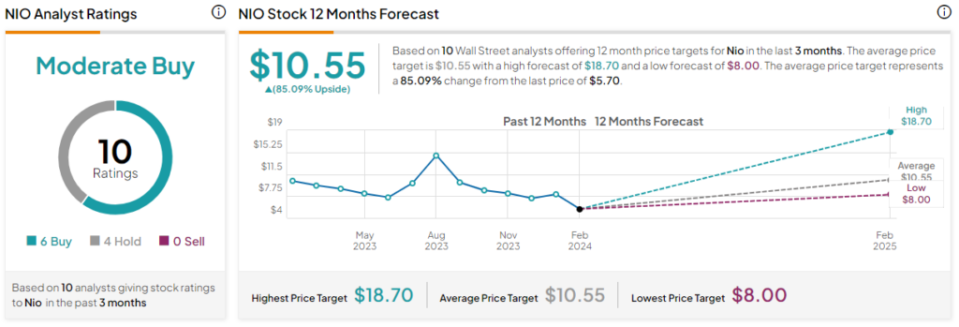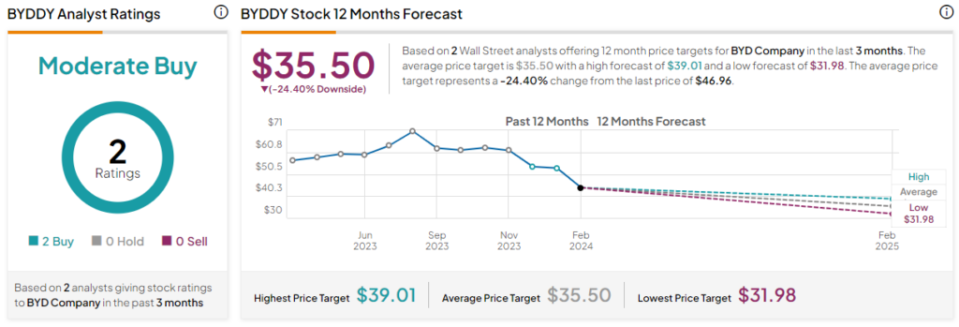NIO vs. BYDDY: Which EV Stock Is the Better Buy?
In this piece, I evaluated two EV stocks, NIO (NYSE:NIO) and BYD (OTC:BYDDY), using TipRanks’ comparison tool to see which stock is the better buy. A closer look suggests a bearish view for NIO and a bullish view for BYD.
China-based NIO designs, manufactures, and sells electric vehicles in China and Hong Kong, the U.S., the U.K., and Germany. Meanwhile, BYD, also based in China, manufactures and sells EVs, rechargeable batteries, and select other electronics, including components for mobile devices.
Shares of NIO have plummeted 33% year-to-date, bringing their 12-month return to -41%. Meanwhile, BYD stock is down 14.8% year-to-date, and shares are down 22.7% over the last year.
Those steep year-to-date declines are in line with the rest of the EV industry due to concerns about weaker-than-expected demand for electric vehicles and the ongoing price war. As a result, even Tesla (NASDAQ:TSLA) is off 26% year-to-date, although the sector-wide drawdown could be offering up some buy-the-dip opportunities.
NIO is not profitable, so we’ll compare its price-to-sales (P/S) ratio to that of BYD to gauge their valuations against each other. For a separate comparable, we’ll use Tesla instead of using the broader auto market, which is skewed due to extreme differences in the valuations of legacy automakers versus EV makers. Tesla is currently trading at a price-to-earnings (P/E) ratio of 42.7 and a P/S of 6.8.
NIO (NYSE:NIO)
At a P/S of 1.4, the cash-burning NIO is trading at a higher valuation than the profitable BYD. With no sign that profitability is in sight and even no plan for achieving it anytime soon, a bearish view looks appropriate for NIO, as there are plenty of better EV plays now with the sector’s recent pullback.
On the one hand, NIO grew its vehicle deliveries by 18.2% year-over-year in January and exceeded its guidance for fourth-quarter deliveries. However, on the other hand, a cursory comparison of other EV makers reveals how much faster most of them are growing compared to NIO. For example, Li Auto (NASDAQ:LI) grew its vehicle deliveries by 105.8% year-over-year in January, while XPeng (NYSE:XPEV) saw its EV deliveries jump 58%.
Then there’s the issue of profitability. Morningstar (NASDAQ:MORN) analyst Vincent Sun said in September that NIO could become profitable in 2026, but the company hasn’t offered any official plan to reach profitability. A key issue for the automaker is its margins, which are being pressured by the ongoing EV price war.
NIO expects its vehicle margins to reach roughly 15% by the fourth quarter, but its margin stood at 11% in the third quarter, down from 16.4% in the third quarter of 2022. Additionally, NIO’s net income margin has remained in the -30% to -40% range for the last four years with no signs of improvement.
Its net income margin stood at -34.5% in 2020, improved to -29.3% in 2021, fell slightly to -29.6% in 2022, and slipped back to -39.2% for the last 12 months, which suggests profitability could be far off. The fact that NIO holds only a 2.1% sliver of the Chinese new-energy-vehicle (NEV) market adds further concern that it could be a long road ahead for the company — if it manages to survive at all.
The one unique thing about NIO is its battery-swapping technology, but it’s too early to say whether it will lead to success for the entire company.
What Is the Price Target for NIO Stock?
NIO has a Moderate Buy consensus rating based on six Buys, four Holds, and zero Sell ratings assigned over the last three months. At $10.55, the average NIO stock price target implies upside potential of 85.1%.
BYD (OTC:BYDDY)
At a P/E of 34.8 and a P/S of 0.9, BYD is trading at a steep discount to Tesla — even though it unseated Elon Musk’s wildly successful EV maker as the world’s largest seller of electric vehicles by delivery count. Thus, a bullish view seems appropriate for BYD, especially considering that the company is undervalued without even considering the non-EV parts of its business.
In 2023, BYD saw its retail sales of new-energy vehicles in China jump 50% year-over-year to 2.7 million units, giving it a 35% share of the Chinese NEV market. Meanwhile, Tesla holds only a 7.8% share of the Chinese market, although its vehicle sales in China grew a perfectly respectable 37.4% year-over-year to more than 600,000 units.
BYD also has its sights set on international markets, as it delivered a record 36,174 vehicles outside China in January. Of course, all of these sales trends are positive for BYD, even if the stock takes a breather temporarily.
One last thing to note about BYD is that this company has been around for many years, having evolved into an EV company that also makes other electronics. As such, BYD has enjoyed some stellar long-term gains in its stock price, which is up 284% over the last five years and 358% over the last 10, making it an attractive buy-and-hold position for the long term.
What Is the Price Target for BYDDY Stock?
BYD has a Moderate Buy consensus rating based on two Buys and no Hold or Sell ratings assigned over the last three months. At $35.50, the average BYD stock price target implies downside potential of 24.4%.
Conclusion: Bearish on NIO, Bullish on BYDDY
It’s no secret that investors are worried about the state of the EV market. High interest rates hit EV sales hard, but it’s starting to look like rates could start coming down at some point this year. Additionally, any dependence on near-term sales trends for EVs is simply short-sighted. Although the transition may take longer than previously expected, the recent pullback in the stock prices of some EV makers presents an attractive buy-the-dip opportunity.
However, when comparing BYD and NIO, it’s clear that BYD is a Chinese juggernaut that’s too cheap to ignore, while NIO looks like a cash-burning, ultra-risky speculative play on battery-swapping technology. If NIO even survives, it could be quite some time before we start to see signs of success peering around the corner.



